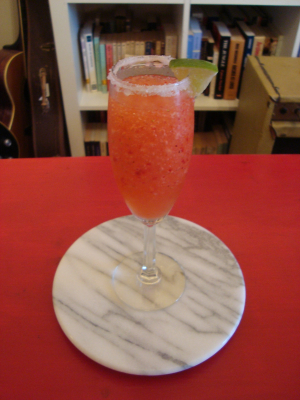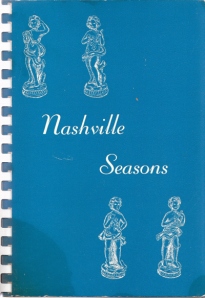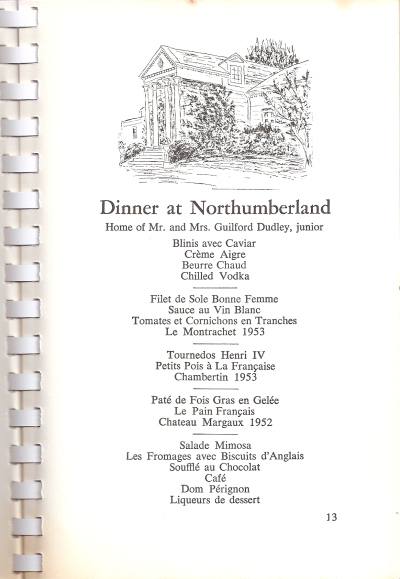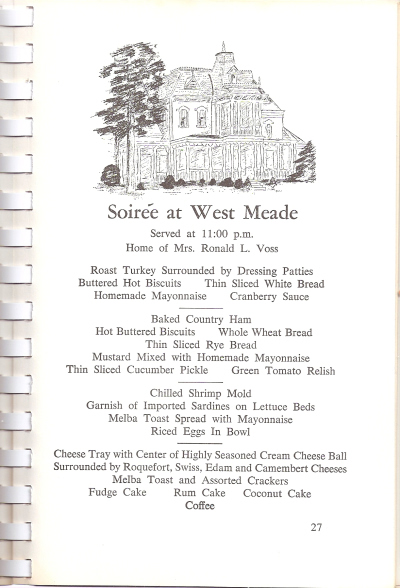(Editor’s Note: Brady Potts, stalwart recipe-taster, occasional food photographer, and general better half, will be stepping in from time to time with a little feature called Drinking With the Junior League, a round-up of cocktails from the cookbooks we’ve explored to date. Nearly every Junior League cookbook includes a section dedicated to lively punches and potent potables suitable for entertaining, and let’s face it, most of us could use a little branching out of our mixology skills. This week’s interlude will feature cocktails from Nashville Seasons, Bay Tables, and Charleston Receipts. Cheers!)
I like to imagine that those of you who’ve been following along with Mary’s journey into the hallowed archives of Junior League cookery have been as impressed as I have with my sweetie’s historiculinary exploits. “Golly,” I imagine you saying as you scroll past pictures of crawfish beignets and cereal tycoons, “there’s a gal who’s on the ball and cute to boot!” But most of all, I like to imagine that you are deeply, profoundly jealous of the amazing food I get to eat every week. And oh, you should be.
(Except for the aspic. Hooboy.)
So in an effort to give Mary a breather – and in a transparent, sad attempt to be more like Don Draper – I’ve volunteered to plunge headfirst into the boozier chapters of the Junior League cookbook history, to a time where afternoon cocktails were a given, and a party just wasn’t a party unless there was a large crystal bowl filled with something pink and flammable, maybe with a pineapple floating in it. First on the list? Straight from Nashville Seasons, we have the classic strawberry Daiquiri.
Strawberry Daiquiri

Nashville Seasons's Strawberry Daiquiri
6 jiggers dark rum
2 jiggers lime juice
Strawberries
Grenadine and sugar to taste
Sweeten lime juice with grenadine and sugar. Combine with rum and 1 tablespoon crushed strawberries. Place in blender of crushed ice, whirl and serve to four delighted guests.
-Mrs. Walter M. Morgan Jr.
My initial foray into boozing with the Junior League is a strange beast indeed. I’m not usually one for boat drinks, but after a long walk to the liquor store on a hot day to procure fixins for one of the more esoteric drinks on this week’s menu, it sounded like just the thing.
(Well, there was that, and then there was the part where I hadn’t noticed that the one I’d been planning on making is to be frozen before it is served.)
As dedicated rummies know, a real daiquiri has almost nothing to do with crushed ice and neon red syrups; the original recipe is really more of a rum gimlet and what most people think of as daiquiris are really little more than booze smoothies. And that’s what we have here, though I admit to being a little baffled by the recipe. Only a tablespoon of crushed strawberries? What madness! I halved the recipe – I do have things to do tonight, after all – and threw in about three rather large strawberries. The result?
A lady, as they say, is never photographed with a drink in hand, but a few more of these and a drink in your hand would be the last thing you’d worry about, picture-wise. Clearly, Mrs. Walter M. Morgan, Jr. enjoyed a good tipple now and then, because her strawberry daiquiri packs a bit of a wallop. That said, it’s very refreshing, and who wants a weak drink anyway? Even with the sextupling of the strawberries in the recipe, the lime was pretty strong, so next time I might err on the side of even more strawberries, or perhaps a little more grenadine.
Still, it isn’t syrupy or oversweet, and for that I give it three swizzle sticks out of four.





 Published in 1964 by the
Published in 1964 by the 
